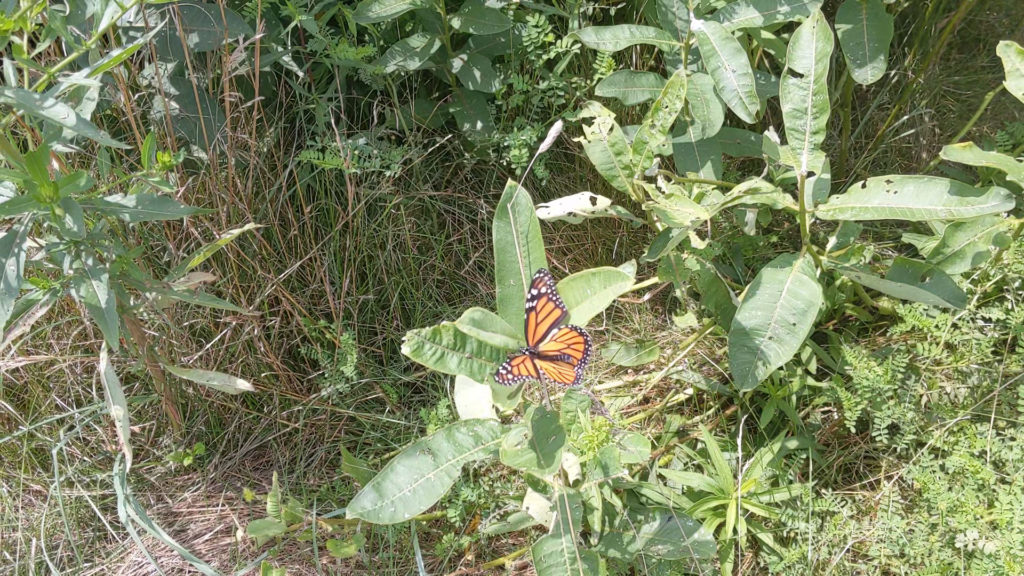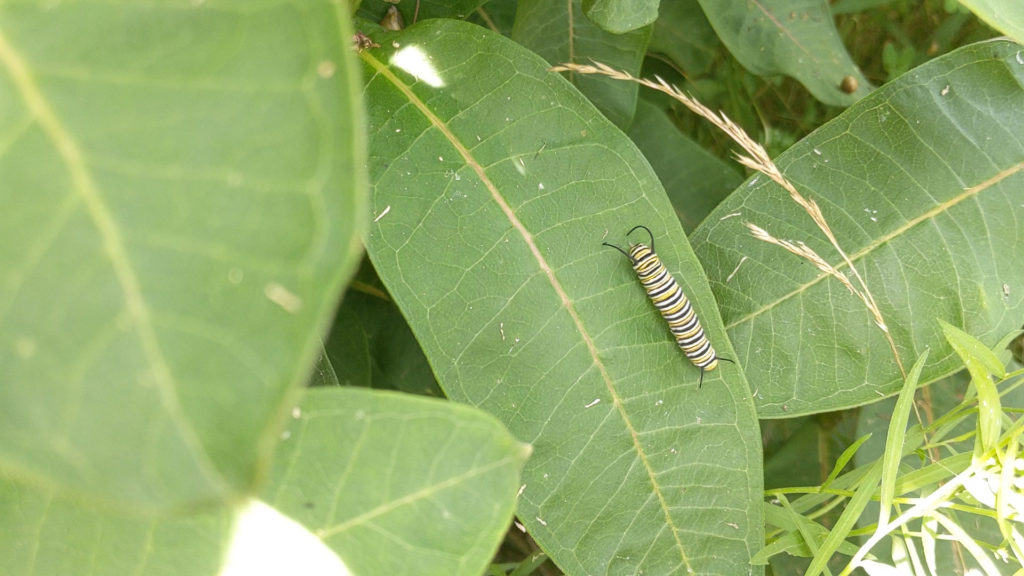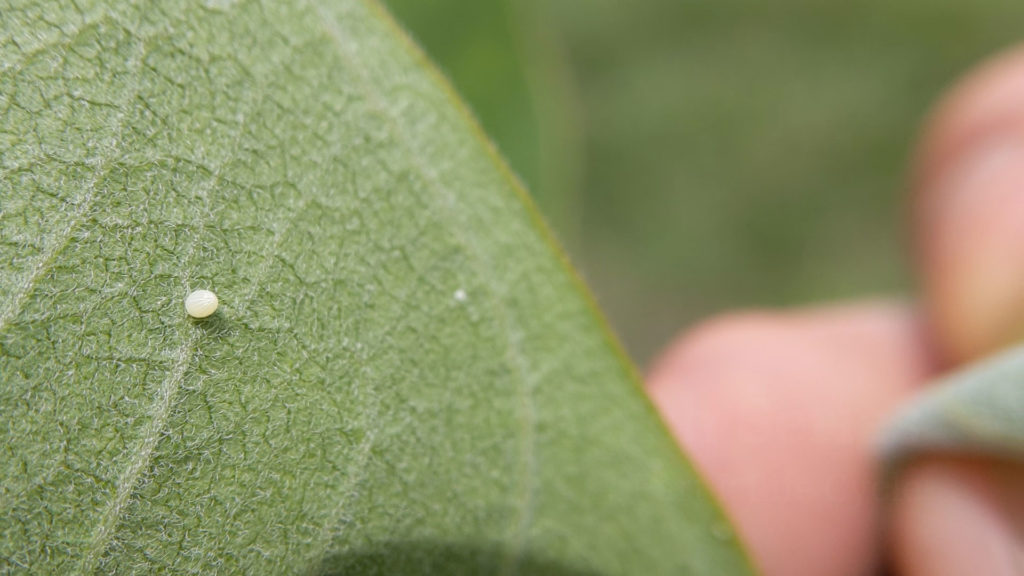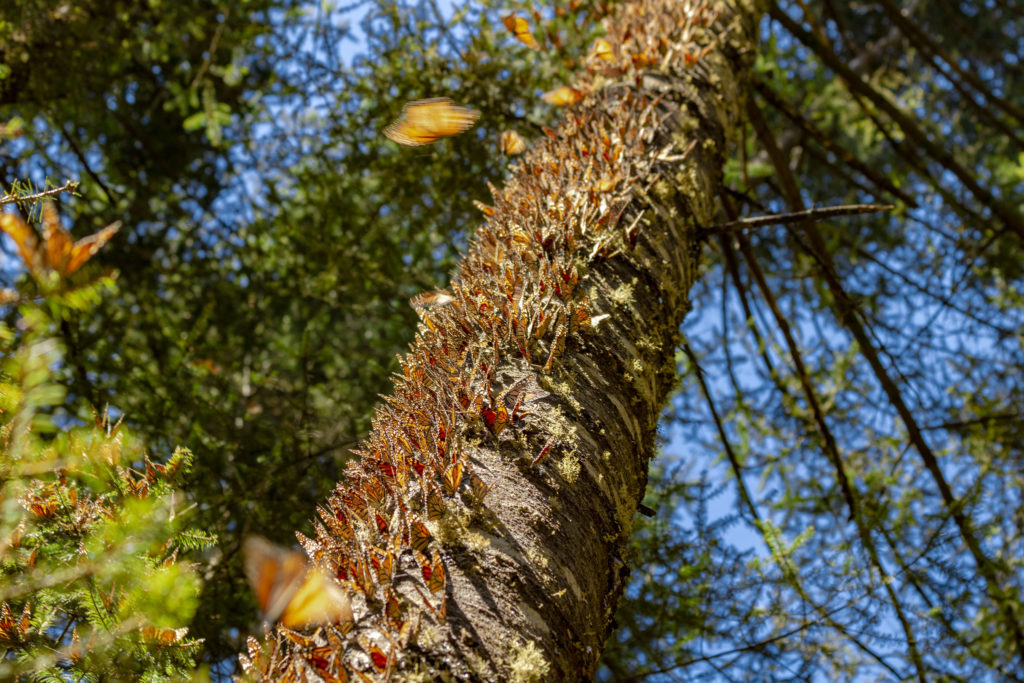Welcome to Creature Feature, a biweekly series from the CELT education team highlighting local wildlife. Each week, we will share a short introduction to a local organism that you might encounter in your backyard or on our trails.
If you are like me, that first sighting of a monarch butterfly is something to celebrate! We began seeing Monarch butterflies here in Maine a few weeks ago. Monarchs are one of the largest butterflies we have in Maine with a wingspan of 3-4 inches. The females are larger than males. Monarchs are easily recognized by their distinctive orange and black wings with white spots on the outer margins.
Monarchs don’t start life as that big beautiful butterfly! Like all insects, they go through several life stages before reaching adulthood. The process begins when a female monarch lays its eggs. Each adult can lay upwards of 200 individual eggs. One by one, each egg is carefully placed on the underside of a milkweed leaf, ensuring that when the tiny caterpillar hatches it will have an abundant supply of food. After 3-5 days, the caterpillar hatches out and immediately begins eating and growing. Once the caterpillar reaches about two inches in length, or 200 times as big as it was when it hatched, it forms a chrysalis. It will then take the caterpillar two more weeks to complete its metamorphosis and emerge as an adult monarch butterfly.



Milkweed plays a critical role in the survival of Monarch butterflies. It is the only food that monarch caterpillars eat. Monarchs have the unique ability to process the toxic “milk” that is found in the milkweed leaves. Not only is it toxic, but very distasteful to many other animals. As the monarch caterpillar eats, it collects this toxin in its body, acquiring a unique defense mechanism against predators that might try to eat it. The toxins remain in the monarch through the caterpillar’s metamorphosis into a butterfly, continuing to protect the monarch from predators as an adult. There are a few insects that will still eat the caterpillars and a few birds that can stand the toxins, but most will leave them alone. The bright yellow stripes of the caterpillar and orange and black striations of the butterfly provide a visual warning that says “I’m toxic! Don’t eat me!” to any predator that might cross its path.
Monarchs have one of the most amazing migration stories in the insect world. If the adult butterfly emerges from its chrysalis in late September, it will notice the shortening length of day and cooler temperatures. Rather than start looking for a mate, it will instead begin a 3000-mile journey to the mountains of Mexico. There, monarchs from across the Eastern and Central US and Canada will cluster together to hibernate on Oyamel trees, with tens of thousands of butterflies per tree. In March, rising temperatures and longer days signal that it is time to head north and back to the US in search of milkweed on which to lay their eggs. (There is no milkweed at the overwintering sites in Mexico.)

Thousands of monarchs on an oyamel tree in Mexico (Photo by Rafael Saldaña CC BY 2.0)
The generation of butterflies that completes the full southward migration and winter hibernation will die during their northward migration, but not before they lay eggs in the Southern US. Their offspring will continue the journey north towards the breeding grounds. It takes two to three generations to complete the journey back to Maine. Interestingly, scientists still don’t fully understand how the Monarchs know when and how to migrate such long distances to a place they have never been.
Over the past century, there has been a significant decline in the Monarch populations all over the US and Canada. This is primarily due to large scale agricultural farming that often destroys milkweed habitat. Pesticides also threaten monarchs themselves. Deforestation of the monarchs wintering ground in Mexico has also had a significant negative impact on the populations.
Luckily, there are many things we can do to help support Monarch butterflies. Planting milkweed native to our area is a simple and very impactful undertaking you can do. Better yet, planting gardens with native flowers will provide a food source for both the butterflies and other friendly pollinators.
There is a lot of great information out there about Monarch butterflies and how to help them. Here are a few of my favorites:
- https://www.monarchwatch.org
- https://www.nwf.org/Educational-Resources/Wildlife-Guide/Invertebrates/Monarch-Butterfly
- https://monarchjointventure.org/monarch-biology
